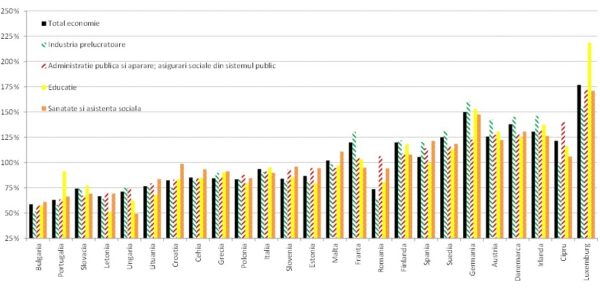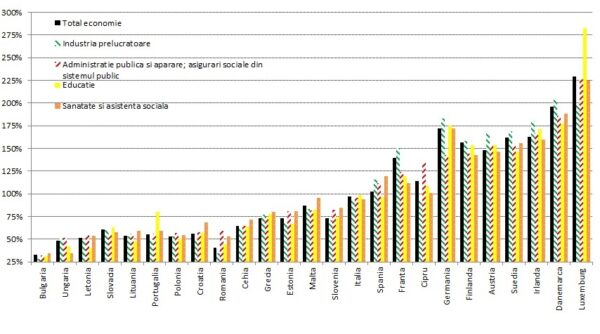Before analysing the two graphs below, let’s set the coordinates:
Expenditures with public sector staff (i.e. state employees) in the 2021 Budget are expected to amount to about RON 110 billion, representing 62% of the total budget. If pensions (including those from CAS) are added to this amount, the amount exceeds 90% of the total budget.
However, Not here is the big Romanian problem of the expenditures for public servants: this is because, relative to GDP (not to the budget), personnel costs are close to the European average.
The big problem is what Romania does with the money for personnel expenses and whom it actually pays: because that shows the vision of the Romanian governing power in recent years, namely in the last decades, regarding the development of the society and the role of the state in society.
This is because teachers, doctors, military personnel, counter staff, the judiciary and ministerial officials are also public sector employees.
A comparative analysis with the EU states, of the way in which public servants are paid in society, shows Romania’s big peculiarity: to how many fields Romanian governments attach importance.
For comparison within national budgets, the analysis also refers to the average salary in the manufacturing industry in each country – the one that, in an industrial Europe, ensures the economy driver, and ultimately, the salaries of public employees of all types.
The graph below represents the average salaries of various types of state employees, compared to the average salary in the manufacturing industry of each country.
The chart was drawn up by Ionut Dumitru, Chief Economist of Raiffeisen Bank and former Chairman of the Fiscal Council and refers to the final data for 2019: because in 2020 Romania is even worse than in this chart.
A graph and its explanations
The 100% line represents the European average of average salaries:
- Total per economy
- Manufacturing industry
- Public administration and defence; public social insurance
- Education
- Health and social assistance
- Bulgaria Portugal Slovakia Latvia Hungary Lithuania Croatia Czech Republic Greece Poland Italy Slovenia Estonia Malta France Romania Finland Spain Sweden Germany Austria Denmark Ireland Cyprus Luxembourg
As we can see, in Romania the best paid public sector employees are those who form the public administration field and various forms of payment for the military.
Health field follows well behind, after which the Education, at an appreciable distance lower.
The manufacturing industry – which is the engine of the economy, has an average salary of almost half the salary of government employees.
The average salary in the total economy is 50% lower than in the administration.
Things are different for the others:
In Bulgaria, health ranks 1st followed by education and the administration only ranks 3rd.
In Poland, the 3 sectors are very close to each other and roughly equal the average salary in the whole economy.
In Hungary, all public sector salaries are lower than in the manufacturing industry, with the note that the second position (surprise ..) is held by the public administration and the last by the health sector.
What to observe in competitive economies:
In Germany, France, Austria, Sweden, Spain and Ireland all categories of public servants have lower salaries than in the manufacturing industry – which comes first.
In the second graph – we can see the above-average salaries in euros:
- Total per economy
- Manufacturing industry
- Public administration and defence; public social insurance
- Education
- Health and social assistance
- Bulgaria Hungary Latvia Slovakia Lithuania Portugal Poland Croatia Romania Czech Republic Greece Estonia Malta Slovenia Italy Spain France Cyprus Germany Finland Austria Sweden Ireland Denmark Luxembourg
And other budgetary problems
Although we insist on the very large number of public servants that Romania would have, this is, at least at this moment, a myth:
Compared to other EU countries and relative to the active population, Romania is close to the European average.
Instead, it has 2 big problems:
1- Of the approximately 1.25 million state employees, about 850,000 work in the central administration.
2- The second major problem is the total number of employees in the economy – very small compared to the total population employed.
It would have been expected, starting with the 2021 Budget, for increases from the administration – some of them hallucinatory – to be somehow cut back, and the anomaly in the graphs above to be corrected: but that already means targeted policies on education and health and a little inconvenience for the big mass of public servants. Because this way of allocation is the residual communism.












